Before the pandemic forced us to take a break from the office, we rarely even left it for lunch. In fact, an estimated 42 per cent of us regularly ate at our desks.
But as Ben Carter of City Pantry points out in this guest article, Lockdown has encouraged many employees to reclaim their lunch hour, and the number of people eating in front of their PCs, has halved in just a few months to 22 per cent.
Where we used to believe multitasking – with a Pret sandwich in hand – was the only way to manage a heavy workload, the majority of UK workers are now eating away from their desks, he writes.
This means we’re not only sitting at our desks for shorter periods (with all the benefits this brings), but we’re learning to become more productive and more mindful of what we’re eating – rather than it being a means to an end.
As a result, COVID-19 is surely the final straw for the ‘desk-side lunch’, but we must keep up this momentum.

Our productivity naturally declines throughout the day, so stepping away from our desks to recharge our batteries is essential to keeping high levels of concentration.
What’s more, lunch breaks are really our only window of opportunity to refocus. When we don’t take the time to move away from our actual place of work – wherever that might be today – we compromise our ability to boost concentration and sacrifice a much-needed productivity refresh.
Eating at our desks also makes it harder to switch off outside working hours, as we become accustomed to dividing our attention between personal time and answering calls or replying to colleagues.
In turn, eating on the job means we aren’t focused on what we are actually putting in our mouths, which can cause us to misinterpret the feelings of fullness, and make us overeat.
Working from home has enabled us to adopt new habits and hobbies, and we need to ensure these are taken into the world once we return to some kind of normal.
At City Pantry, since March, we’ve seen a huge rise in the number of healthy home cooking meal kits being ordered through our partners, whilst ‘fast-food’ orders, such as pizza or chips, were at an all-time low in April 2020, making up only 5.35 per cent of all orders.
This shows that lockdown has encouraged people to use their lunch breaks to curate a better, healthier work-life balance and adopt more rounded lifestyles – whether it’s exercise or taking time to cook from scratch, both of which help reduce stress and increase productivity.
now is the time for employers to encourage healthier attitudes towards lunch
As offices start to reopen, strict new rules and regulations will present many challenges, but eating lunch at our desks should be one of the first things to go.
As the saying goes ‘old habits die hard’ but it’s imperative that we don’t simply revert back to our pre-COVID ways.
Government guidance states that corporations should encourage workers to bring in their own food, and where possible, reconfigure seating/table arrangements to reduce face-to-face interaction.
This could mean that eating at our desks is the one of the safest options. But now is the time for employers to encourage healthier attitudes towards lunch – whether this means eating in a separate part of the office, or making use of outside spaces to encourage workers away from their desks during their lunch.
Just because we are back in an office, shouldn’t mean we revert back to our old lunchtime habits of eating in an office.
Having open discussions around the benefits of taking breaks will be essential to maintaining this healthier work culture, and ensuring employees continue to take breaks needs to become part of the ‘new normal’ we talk so much about.
There are very few positives to take from the pandemic, but maintaining this simple change needs to be one of them.


